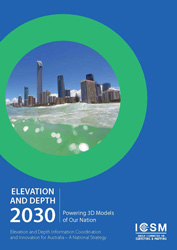Elevation and Depth 2030: Powering 3D Models of Our Nation
Elevation and Depth Information Coordinating and Innovating for Australia – A National Strategy.
Welcome to Elevation and Depth 2030. This strategy is about taking positive steps to achieve consistent nationwide digital elevation and depth models that people can interrogate with other information to make good decisions for the betterment of our community.
When will the fire reach my place?
Will the community hall be flooded?
Where do I position my windfarm and what is the optimum design?
Which road should I take to avoid a fire blocking my path?
How much under-keel clearance will a cargo ship have when navigating shallow waters?
These questions and thousands more rely intrinsically on elevation and depth data. ICSM want to provide the fundamental data to answer those and many other new questions, so have developed a future strategic vision for elevation and depth data.
Elevation and depth information is critical to public safety, climate change studies and industry automation, and yet it is one of the most underutilised government data assets. The size, cost and complexity of elevation and depth data makes it difficult to acquire, curate, process and interpret, and as a consequence, it is largely used only by expert data analysts.
Being able to visualise our environment as a 3-dimensional model is one of the most significant ways we can help people make sense of their location. It is time to shift our attention to promoting and coordinating investment in the innovative use of elevation and depth data.
To make a difference to our future, we must fundamentally change the way elevation and depth data is managed, and consider new ways to collect, curate, and enable access and use for all Australians.
ANZLIC will use this strategy to transition the Elevation and Depth theme in the ANZ Foundation Spatial Data Framework (FSDF) to become a more valuable asset.
Download the Strategy - Elevation and Depth 2030
Discover and Download Available Elevation and Depth Data – elevation.fsdf.org.au
Digital Elevation Data Guidelines and Specifications
In November 2010 ICSM released the LiDAR Acquisition Specifications and Tender Template, Version 1.0. This is available in two formats:
- LiDAR_Specifications_and_Tender_Template.pdf (278KB)
- LiDAR_Specifications_and_Tender_Template.doc (881KB)
In September 2011 ICSM released the New Zealand LiDAR Acquisition Specifications and Tender Template Version 1.0. Also available in both MS Word and PDF formats:
- NZ-LiDAR_Specifications_and_Tender_Template.pdf (247Kb)
- NZ-LiDAR_Specifications_and_Tender_Template.doc (803KB)
In recent years dramatic developments in LiDAR technology and industry capabilities have revolutionised our ability to address these issues at the local level. However, inconsistent and diverse product specifications, and variable data quality are often making it difficult to integrate datasets to address regional, state and national issues. In order to optimise investment and the utility of both existing and future data collections there is a need for a national base specification which defines a consistent set of minimum products which ensure compatibility across projects and States.
The intent of this specification and tender template is to improve on the quality, consistency, utility and compatibility of data being captured by government and commercial off-the-shelf (COTS) products increasingly being offered by the private sector. Moreover, the specifications and tender template provide opportunities for greater collaborative investment across all levels of government, and capacity to reduce tender and compliance costs for investors and providers.
Use of these specifications will also ensure that primary LiDAR point cloud data and derived products can be easily integrated and ingested into the Elevation Information System (ELVIS), providing increased discoverability and access to the broader user community.
The specifications have drawn on recent experience across all levels of Australian government, consultation with LiDAR data providers, and the U.S. Center for LiDAR Information, Coordination and Knowledge (CLICK). They provide a minimum base specification and are not intended to limit development of more specialised products. Nor are they intended to inhibit industry development and innovation. We therefore encourage interested users, investors, researchers and suppliers to contribute to ongoing development.
This specification builds on the previously released Guidelines for Digital Elevation Data, Version 1.0 (401KB). The Guidelines represent a first cut in the preparation of ‘best practice’ guidelines for Australia using common technologies. The Guidelines for Digital Elevation Data will be revised in the future to include the advances in understanding specifically relating to LiDAR included in the LiDAR Acquisition Specifications and Tender Template.
For further information on ELVIS and related initiatives please visit the Geoscience Australia site at http://www.ga.gov.au/scientific-topics/national-location-information/digital-elevation-data.
These guidelines are considered a living document. If you have any questions or comments on the guidelines please email the ICSM Executive Officer at icsm@ga.gov.au.
Discoverability and Accessibility to Depth Data
High-resolution depth model for the Great Barrier Reef and Coral Sea - 100 m
https://s3-ap-southeast-2.amazonaws.com/elvis.ga.gov.au/bathy/100_DEM/gbr100_v5.zip
High-resolution depth model for the Northern Australia – 100 m
https://s3-ap-southeast-2.amazonaws.com/elvis.ga.gov.au/bathy/100_DEM/nthaus100_v3.zip

